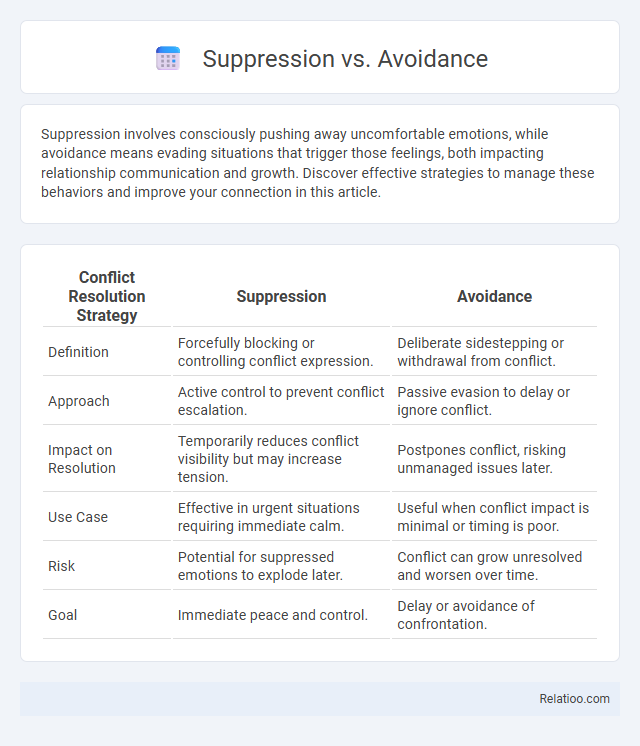Suppression involves consciously pushing away uncomfortable emotions, while avoidance means evading situations that trigger those feelings, both impacting relationship communication and growth. Discover effective strategies to manage these behaviors and improve your connection in this article.
Table of Comparison
| Conflict Resolution Strategy | Suppression | Avoidance |
|---|---|---|
| Definition | Forcefully blocking or controlling conflict expression. | Deliberate sidestepping or withdrawal from conflict. |
| Approach | Active control to prevent conflict escalation. | Passive evasion to delay or ignore conflict. |
| Impact on Resolution | Temporarily reduces conflict visibility but may increase tension. | Postpones conflict, risking unmanaged issues later. |
| Use Case | Effective in urgent situations requiring immediate calm. | Useful when conflict impact is minimal or timing is poor. |
| Risk | Potential for suppressed emotions to explode later. | Conflict can grow unresolved and worsen over time. |
| Goal | Immediate peace and control. | Delay or avoidance of confrontation. |
Understanding Suppression and Avoidance
Suppression involves consciously pushing distressing thoughts or emotions out of awareness to reduce immediate psychological discomfort, often leading to increased mental effort and potential rebound effects. Avoidance refers to behaviors aimed at evading situations, stimuli, or emotions that trigger anxiety or distress, which may provide short-term relief but can reinforce long-term fear and maladaptive coping patterns. Understanding the distinction highlights that suppression targets internal experiences directly, while avoidance focuses on external situations, influencing different therapeutic strategies in cognitive-behavioral interventions.
Key Differences Between Suppression and Avoidance
Suppression involves consciously pushing away unwanted thoughts or emotions, while avoidance is the act of steering clear of situations or stimuli that trigger those thoughts or feelings. Suppression is an internal mental control mechanism, whereas avoidance is an external behavior aimed at preventing exposure to distress. Key differences include suppression requiring active mental effort to manage emotions, contrasted with avoidance relying on evasion strategies to minimize discomfort.
Psychological Mechanisms at Play
Suppression involves consciously inhibiting unwanted thoughts or emotions, engaging executive control functions in the prefrontal cortex to temporarily block awareness. Avoidance operates through behavioral or cognitive strategies to prevent exposure to distressing stimuli, often reinforcing anxiety via negative reinforcement and engaging amygdala-driven fear responses. Repression, an unconscious defense mechanism, automatically excludes disturbing content from conscious awareness by modulating activity in brain regions associated with emotional regulation, such as the hippocampus and anterior cingulate cortex.
Common Triggers for Suppression and Avoidance
Common triggers for suppression include intrusive thoughts, anxiety-provoking memories, and unwanted emotions that individuals consciously push away to reduce distress. Avoidance is typically triggered by fear of specific situations, objects, or experiences perceived as threatening, leading to deliberate evasion to prevent discomfort. Both suppression and avoidance serve as coping mechanisms but differ in their immediate focus: suppression targets internal distress, while avoidance addresses external stimuli.
Emotional Impact of Suppressing vs Avoiding
Suppressing emotions involves consciously pushing feelings out of awareness, often leading to increased physiological stress and emotional exhaustion over time. Avoidance entails steering clear of situations that trigger negative emotions, which may reduce immediate distress but can reinforce anxiety and limit emotional processing. Research shows that suppression typically results in greater emotional impact and decreased well-being compared to avoidance, as it inhibits natural emotional regulation and prolongs negative feelings.
Long-Term Consequences on Mental Health
Suppression, avoidance, and repression differ significantly in their long-term impacts on mental health, with suppression involving conscious effort to control emotions, leading to increased stress and anxiety if persistent. Avoidance, characterized by evading distressing thoughts or situations, often results in heightened fear and reduced coping skills over time, contributing to chronic mental health issues like depression. Repression, an unconscious process of blocking traumatic memories, may cause unresolved psychological conflicts and symptoms such as dissociation or increased vulnerability to mental disorders.
Coping Strategies for Suppression and Avoidance
Coping strategies for suppression involve consciously pushing unwanted thoughts or emotions out of your awareness, often requiring mental discipline and mindfulness techniques to effectively manage stress without exacerbating internal conflict. Avoidance strategies, on the other hand, focus on steering clear of situations, people, or triggers that cause distress, which can provide temporary relief but may contribute to increased anxiety over time if relied upon excessively. Your ability to balance these approaches depends on recognizing when each strategy supports emotional regulation versus when it hinders long-term psychological well-being.
Suppression and Avoidance in Everyday Life
Suppression and avoidance are common coping mechanisms used in everyday life to manage stress and negative emotions. Suppression involves consciously inhibiting unwanted thoughts or feelings, allowing individuals to maintain focus on present tasks, while avoidance entails steering clear of situations or triggers that provoke discomfort or anxiety. Effective use of suppression can improve short-term emotional regulation, but excessive reliance on avoidance may limit personal growth and increase long-term stress.
When Suppression or Avoidance Becomes Problematic
Suppression and avoidance become problematic when they interfere with your ability to process emotions and address underlying issues, leading to increased stress or anxiety over time. Persistent suppression can cause emotional tension and may exacerbate mental health conditions, while avoidance often results in missed opportunities for growth and unresolved conflicts. Recognizing when these coping mechanisms hinder your well-being is crucial for seeking healthier emotional regulation strategies.
Building Healthier Emotional Responses
Suppression involves consciously blocking out unwanted emotions, which can lead to increased stress and emotional buildup over time, while avoidance entails steering clear of triggers, often resulting in unresolved issues and heightened anxiety. Building healthier emotional responses requires acknowledging and processing feelings through strategies like mindfulness and cognitive restructuring, promoting emotional resilience and long-term well-being. Integrating acceptance rather than suppression or avoidance fosters adaptive coping mechanisms and improved mental health outcomes.

Infographic: Suppression vs Avoidance
 relatioo.com
relatioo.com